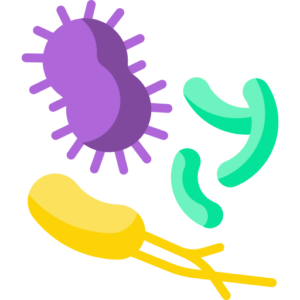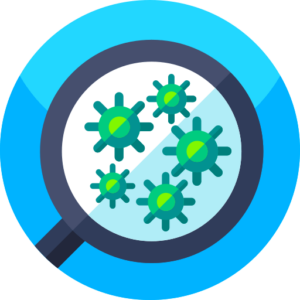Many are interested in how to nourish the gut microbiome, particularly if you’re on a low FODMAP diet.
Several foods which are important for maintaining a healthy microbiome are restricted on this diet.
In this article, we will look at how you can optimize your gut microbiome and still adhere to the low FODMAP diet.
What Is The Gut Microbiome?

The gut microbiome is collectively the term used to describe the 100 trillion microbes, their functions and genes, which live in our digestive tract.
This includes bacteria, yeast, fungi, and parasites, of which there are over several hundred species in the gut. The microbiome is considered to be its own organ due to its multitude of functions in the body. It even has its own independent nervous system – hence known as the ‘second brain’. (1, 2, 3)
The importance of a healthy gut microbiome is due to the role it plays in several aspects of health including weight management, immunity, inflammatory response, hormone regulation, mental health and the link with the brain through the gut brain axis.
The mechanisms by which the gut microbiome influences these are complex, but include production of metabolites which protect the intestinal wall, synthesis of neurotransmitters which signal to the brain and regulation of immune cells. (4)
Each person’s gut microbiome is unique to them. The makeup of the gut microbiome is developed from birth, and changes over a lifespan from influences such as diet, lifestyle, environment, genes, medical treatments and stress. (5, 6, 7)
The ‘healthiest’ makeup of the gut microbiome contains a high balance of a diverse range of species of beneficial bacteria (such as Lactobacillus and Bifidobacterium) and a low balance of pathogenic bacteria (such as Staphylococcus or Clostridium). Ultimately like a diverse and flourishing garden without the weeds. (2, 8)
Summary: The gut microbiome is made up of 100 trillion microbes and has so many functions within the body it is considered to be its own organ. Having a high diversity of beneficial bacteria is the healthiest makeup of the gut microbiome.
How Is The Gut Microbiome Related To The Low FODMAP Diet?

The low FODMAP diet is used as a first-line treatment for people who have recurrent gastrointestinal issues.
Dysbiosis is an imbalance of species of bacteria (ie. low diversity of species of beneficial bacteria). People who have gut disorders such as irritable bowel syndrome (IBS) and irritable bowel disease (IBD) have been found to have an altered microbiome composition in comparison to a normal healthy person. (9)
Restrictive diets such as the low FODMAP diet or gluten-free diet can then have an adverse impact on the balance and diversity of the gut microbiome. Although it is effective for reducing IBS symptoms, the low FODMAP diet increases dysbiosis after just 4 weeks. (4, 10)
It is possible to include plenty of foods in your diet which both adhere to the low FODMAP diet and improve your gut microbiome too.
Summary: Those with gut disorders may have an altered microbiome composition known as dysbiosis. The low FODMAP diet increases dysbiosis after just four weeks. It is still possible to include plenty of foods which improve the gut microbiome on this diet.
How To Maintain A Healthy Gut Microbiome On The Low FODMAP Diet

The best diet for a healthy gut microbiome is a diverse and varied diet.
The more diverse your diet, the more diverse your microbiome will be. (11)
The mediterannean diet seems to be especially effective in keeping your gut microbiome healthy. This diet is rich in plant based fats, high in polyphenols and antioxidants, has a high intake of fiber and higher plant over animal protein intake. (12)
It’s never too late to improve your microbiome through diet. One study which swapped a typical high-fat, low-fiber typical western style diet for a high-fiber, low-fat African style diet found remarkable changes in the participants’ gut microbiome in just two weeks. (13)
Prebiotics
Prebiotics are a specific type of fiber which is fermented in the large intestine by probiotic bacteria.
The fermentation process produces short chain fatty acids (SCFA’s) such as butyrate, acetate and propionate which help protect the lining of our gut and have anti-inflammatory properties. (14, 15)
Prebiotic fibers are the preferred fuel source of gut bacteria, and in turn there are several benefits to these kinds of fibers helping probiotics be more effective. These include improving the makeup of gut bacteria in favor of beneficial bacteria and increased immunity. (16, 17, 18)
All prebiotics are types of fiber, but not all dietary fibers are prebiotic. It is important to include a variety of dietary fibers in your diet as this is supportive of microbial diversity and good gut health. Foods which contain types of fiber such as cellulose, hemicelluloses, pectins, gums, fructans and resistant starches are all beneficial, if tolerated. (19)
Low FODMAP High-Fiber Foods Which Support Your Microbiome
The low FODMAP diet excludes a lot of prebiotic foods because many of these are high FODMAP.
These include:
- Onions
- Garlic
- Jerusalem artichoke
- Asparagus
- Peas
- Ripe bananas
- Apples
- Wheat
While the fermentation of prebiotic fibers is highly beneficial, one of the side effects is that it produces gas which can cause bloating and abdominal pain. (19)
There are still a wide variety of high-fiber and prebiotic foods which can be enjoyed on a low FODMAP diet. Some FODMAP containing foods are safe to consume up to a certain quantity, but it is important to be aware of FODMAP stacking.
Eat a variety of these low FODMAP high-fiber foods to keep your microbes happy:
Vegetables
- Chicory, up to 75g
- Red or common cabbage, up to 75g
- Chinese cabbage (wombok), up to 75g
- Lentils (½ cup canned lentils, 2 tbsp puy lentils)
- Edamame (½ cup)
- Canned chickpeas (¼ cup)
- Canned black beans (¼ cup)
- Sprouted mung beans (⅔ cup)
- Potatoes (keep the skin on)
- Carrots
Fruit
- Tomatoes
- Cocoa beans – a good dark chocolate >85% is best!
- Citrus fruits (except grapefruit)
- Raspberries and strawberries
- Unripe (green) bananas
Nuts and seeds
- Chia seeds
- Pumpkin seeds
- Walnuts
- Almonds (up to 10)
Grains
- Oats
- Wholegrain rice
- Quinoa
Probiotics
Taking probiotics can also have a positive impact on your gut microbiome.
There are particular probiotic varieties which have been shown to be effective in treating IBS symptoms. They can improve the balance of gut bacteria by replacing certain species which IBS patients are typically low in (such as Lactobacilli and Bifidobacteria).
On the other hand, taking probiotics is a ‘band-aid’ solution, and should not be thought of as a long term treatment. Probiotics are certainly effective in favourably altering the composition of the gut microbiome, however it is the diet overall and the kinds of fibers eaten which ‘feed’ the bacteria and allow them to flourish which are the most important.
Additional Changes You Can Make
In addition to the points above here are more tips:
- Use a good quality olive oil: Fats from plant based sources such as extra virgin olive oil are associated with increased microbial diversity. This could be because of the types of fats in olive oil (high amounts of mono and polyunsaturated fats), but also because it contains high amounts of polyphenols and phytochemicals such as antioxidants. (20)
- Drink beverages high in polyphenols: Polyphenols are plant chemicals with several health benefits which can positively influence the gut microbiome. This may be because of prebiotic properties or antimicrobial activities against the ‘bad’ bacteria. High amounts of polyphenols are found in many of the plant foods mentioned above (eg. cocoa, berries), but you can also get a boost from drinking tea and coffee, and even a glass of red wine. (21, 22)
- Get some exercise and manage stress: Chronic stress, which can be the cause of IBS symptoms for some, has a negative impact on the makeup of your gut bacteria. Managing stress through meditation, exercise or counselling could help. Exercise is especially helpful, as this is shown to improve microbial diversity. (23, 24)
What To Avoid To Optimize Your Microbiome
Lastly, there are some lifestyle habits which are known to have a negative effect on the microbiome which can be avoided.
Regular alcohol consumption, other than the recommended daily glass of red wine, reduces beneficial gut bacteria. Smoking also contributes to gut dysbiosis and should be avoided. (22, 25)
Artificial sweeteners are another one to avoid as they may have a negative impact on the gut microbiome. Low FODMAP sweeteners saccharin, sucralose and stevia appear to alter the composition of gut bacteria. (26)
Summary: A diverse and varied diet is best for a healthy and diverse gut microbiome. Prebiotic fiber is most beneficial, and although the low FODMAP diet excludes a lot of prebiotic foods there are still a variety of high-fiber foods which can be enjoyed. There are additional options you can try as well.
Is The Low FODMAP Diet Ruining My Gut Microbiome?
The reality is that the low FODMAP diet does limit prebiotic fibers that are important for the gut microbiome.
This is why you’re strongly encouraged to reintroduce foods with the help of a dietitian. Doing so will increase the variety of your diet whilst still identifying your food triggers.
In addition be sure to implement the diet and lifestyle recommendations we have mentioned.
